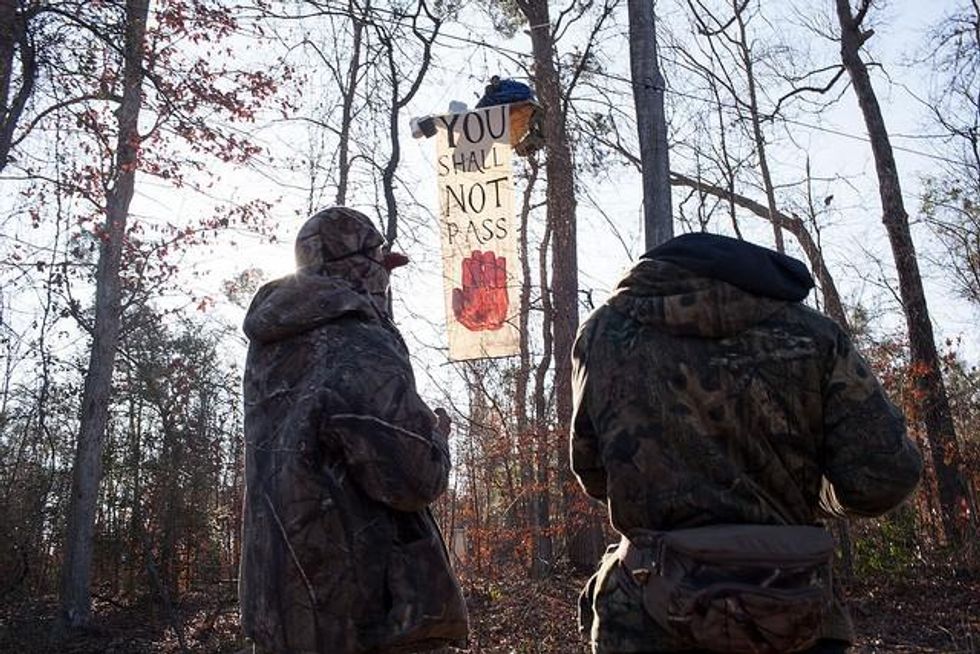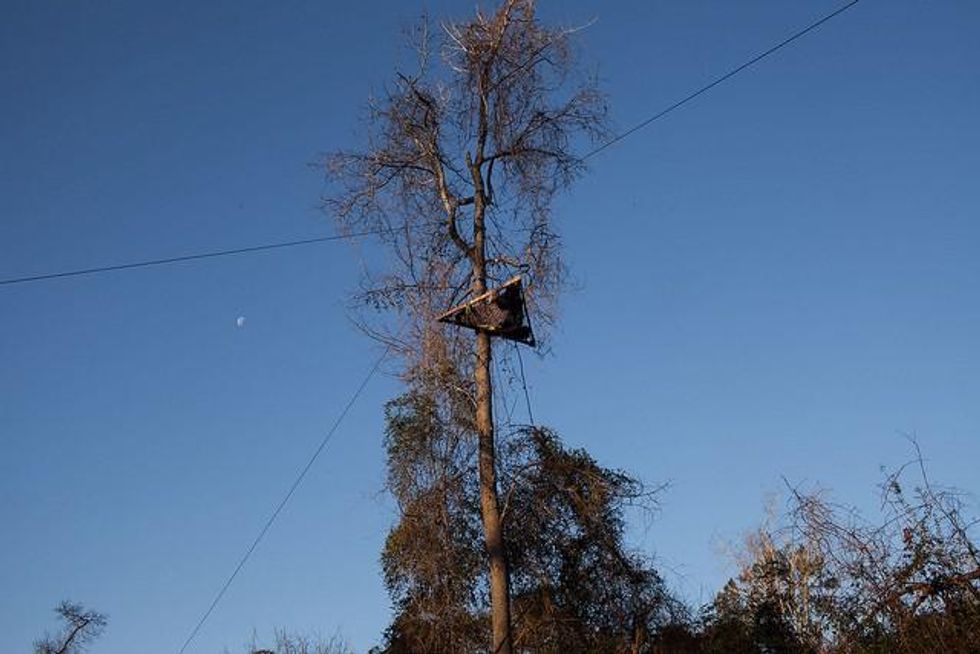Tar Sands Activists' Lives on the Line: Back in the Trees to Block Keystone XL
'Protecting the living systems which we’re a part of is a moral necessity,' says blockader

Fresh off the heels of an 85-day tree-sit near Winnsboro, TX, and other correlating actions wherein the group eventually forced pipeline company TransCanada to reroute their Keystone XL pipeline southern leg plans, activists have positioned themselves directly in the pipeline's new path, once again, this time near Diboll, Texas.
"This new site is surrounded by barriers like Highway 59, railroad tracks, and Ryan Lake. With these nearby, blockaders have found a location around which the pipe cannot easily be rerouted," the group stated Thursday.
To accomplish the task, late Wednesday night two blockaders suspended themselves from several tall trees, which have been designated for clearing, 60 feet in the air. The blockaders are balancing on two separate "dump platforms."
The "dump platforms" are held in place by "an unprecedented 80-100 ft perimeter of life-lines" arranged in such a way that if disturbed the blockaders would fall. (See below photo to visualize the blockade method).
"The viability of this blockade depends entirely on the safe conduct of TransCanada and local police forces. They could easily end it by cutting ropes and seriously injuring or killing the tree sitters. Blockaders Audrey and Mike know the risks. They are prepared to stay on their platforms, just big enough to lie down on, indefinitely, to defend their collective home from the expansion of tar sands exploitation that Keystone XL would usher in," the group writes today.
"Protecting the living systems which we're a part of is a moral necessity," said blockader Audrey, who is sitting in a singular tree left in a newly-cleared field. "Extraction of the tar sands is the most destructive project on the continent. It threatens the integrity of the entire biosphere, not to mention the First Nations dependent upon access to clean water, land, and air for the health and food for their tribal communities."
"Institutional methods of addressing climate change have failed us," explained Ron Seifert, a Tar Sands Blockade spokesperson. "Rising up to defend our homes against corporate exploitation is our best and only hope to preserve life on this planet. We must normalize and embrace direct, organized resistance to the death machine of industrial extraction and stand with those like Idle No More who take extraordinary risk to defend their families and livelihoods."

See more photos here.
_______________________
The group released a video of the blockade preparations:
An Urgent Message From Our Co-Founder
Dear Common Dreams reader, The U.S. is on a fast track to authoritarianism like nothing I've ever seen. Meanwhile, corporate news outlets are utterly capitulating to Trump, twisting their coverage to avoid drawing his ire while lining up to stuff cash in his pockets. That's why I believe that Common Dreams is doing the best and most consequential reporting that we've ever done. Our small but mighty team is a progressive reporting powerhouse, covering the news every day that the corporate media never will. Our mission has always been simple: To inform. To inspire. And to ignite change for the common good. Now here's the key piece that I want all our readers to understand: None of this would be possible without your financial support. That's not just some fundraising cliche. It's the absolute and literal truth. We don't accept corporate advertising and never will. We don't have a paywall because we don't think people should be blocked from critical news based on their ability to pay. Everything we do is funded by the donations of readers like you. Will you donate now to help power the nonprofit, independent reporting of Common Dreams? Thank you for being a vital member of our community. Together, we can keep independent journalism alive when it’s needed most. - Craig Brown, Co-founder |
Jacob Chamberlain is a former staff writer for Common Dreams. He is the author of Migrant Justice in the Age of Removal. His website is www.jacobpchamberlain.com.

Fresh off the heels of an 85-day tree-sit near Winnsboro, TX, and other correlating actions wherein the group eventually forced pipeline company TransCanada to reroute their Keystone XL pipeline southern leg plans, activists have positioned themselves directly in the pipeline's new path, once again, this time near Diboll, Texas.
"This new site is surrounded by barriers like Highway 59, railroad tracks, and Ryan Lake. With these nearby, blockaders have found a location around which the pipe cannot easily be rerouted," the group stated Thursday.
To accomplish the task, late Wednesday night two blockaders suspended themselves from several tall trees, which have been designated for clearing, 60 feet in the air. The blockaders are balancing on two separate "dump platforms."
The "dump platforms" are held in place by "an unprecedented 80-100 ft perimeter of life-lines" arranged in such a way that if disturbed the blockaders would fall. (See below photo to visualize the blockade method).
"The viability of this blockade depends entirely on the safe conduct of TransCanada and local police forces. They could easily end it by cutting ropes and seriously injuring or killing the tree sitters. Blockaders Audrey and Mike know the risks. They are prepared to stay on their platforms, just big enough to lie down on, indefinitely, to defend their collective home from the expansion of tar sands exploitation that Keystone XL would usher in," the group writes today.
"Protecting the living systems which we're a part of is a moral necessity," said blockader Audrey, who is sitting in a singular tree left in a newly-cleared field. "Extraction of the tar sands is the most destructive project on the continent. It threatens the integrity of the entire biosphere, not to mention the First Nations dependent upon access to clean water, land, and air for the health and food for their tribal communities."
"Institutional methods of addressing climate change have failed us," explained Ron Seifert, a Tar Sands Blockade spokesperson. "Rising up to defend our homes against corporate exploitation is our best and only hope to preserve life on this planet. We must normalize and embrace direct, organized resistance to the death machine of industrial extraction and stand with those like Idle No More who take extraordinary risk to defend their families and livelihoods."

See more photos here.
_______________________
The group released a video of the blockade preparations:
Jacob Chamberlain is a former staff writer for Common Dreams. He is the author of Migrant Justice in the Age of Removal. His website is www.jacobpchamberlain.com.

Fresh off the heels of an 85-day tree-sit near Winnsboro, TX, and other correlating actions wherein the group eventually forced pipeline company TransCanada to reroute their Keystone XL pipeline southern leg plans, activists have positioned themselves directly in the pipeline's new path, once again, this time near Diboll, Texas.
"This new site is surrounded by barriers like Highway 59, railroad tracks, and Ryan Lake. With these nearby, blockaders have found a location around which the pipe cannot easily be rerouted," the group stated Thursday.
To accomplish the task, late Wednesday night two blockaders suspended themselves from several tall trees, which have been designated for clearing, 60 feet in the air. The blockaders are balancing on two separate "dump platforms."
The "dump platforms" are held in place by "an unprecedented 80-100 ft perimeter of life-lines" arranged in such a way that if disturbed the blockaders would fall. (See below photo to visualize the blockade method).
"The viability of this blockade depends entirely on the safe conduct of TransCanada and local police forces. They could easily end it by cutting ropes and seriously injuring or killing the tree sitters. Blockaders Audrey and Mike know the risks. They are prepared to stay on their platforms, just big enough to lie down on, indefinitely, to defend their collective home from the expansion of tar sands exploitation that Keystone XL would usher in," the group writes today.
"Protecting the living systems which we're a part of is a moral necessity," said blockader Audrey, who is sitting in a singular tree left in a newly-cleared field. "Extraction of the tar sands is the most destructive project on the continent. It threatens the integrity of the entire biosphere, not to mention the First Nations dependent upon access to clean water, land, and air for the health and food for their tribal communities."
"Institutional methods of addressing climate change have failed us," explained Ron Seifert, a Tar Sands Blockade spokesperson. "Rising up to defend our homes against corporate exploitation is our best and only hope to preserve life on this planet. We must normalize and embrace direct, organized resistance to the death machine of industrial extraction and stand with those like Idle No More who take extraordinary risk to defend their families and livelihoods."

See more photos here.
_______________________
The group released a video of the blockade preparations:

